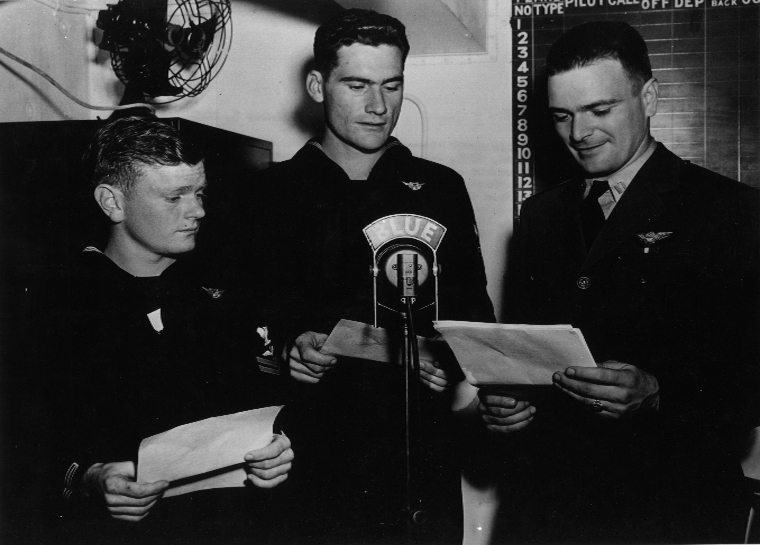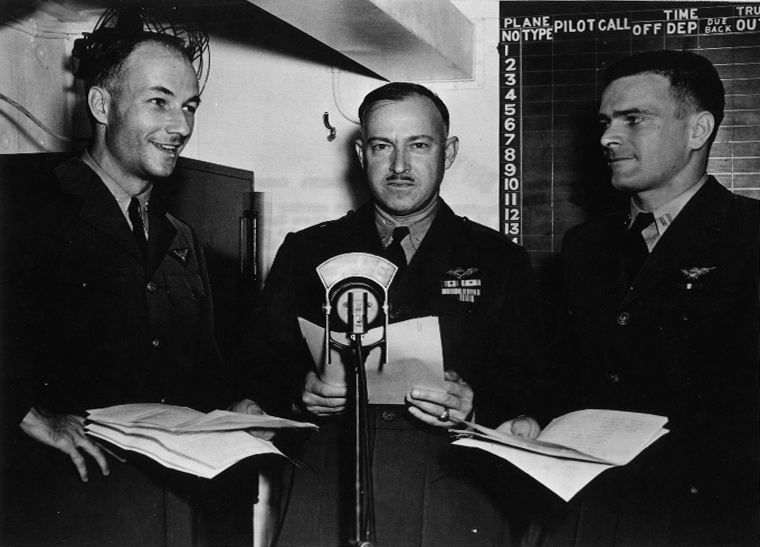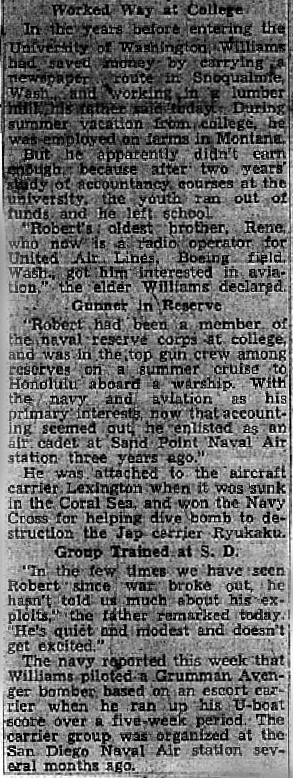NAVY DEPARTMENT |
||
IMMEDIATE RELEASE |
||
| PRESS AND RADIO | ||
NAVY PILOT SINKS THREE U-BOATS |
||
| Lieutenant Robert Pershing Williams, U.S.N.R., 26-year-old Naval pilot of Snoqualmie, Washington, during a period of six weeks, destroyed two U-boats, bombed another into such helplessness that it was readily sent to the bottom by another plane and possibly damaged a fourth underseas raider. | ||
| Lieutenant Williams, pilot of a Grumman AVENGER bomber, is attached to one of the Navy’s new escort aircraft carriers assigned to anti-submarine patrol and escort duty in the Atlantic. | ||
| Lieutenant Williams formerly was attached to the USS LEXINGTON. He was awarded the Navy Cross as a dive bomber pilot “for extraordinary heroism and conspicuous devotion to duty” during the Battle of Coral Sea, May 7, 1942. His Navy Cross citation read in part: “in the face of heavy antiaircraft fire and fierce fighter opposition, he dived his plane at an enemy aircraft carrier and released his bomb with calm and accuracy. By grim determination and expert appraisal of his objective, he contributed materially to the high percentage of hits inflicted by his particular squadron and assisted in the ultimate destruction of the enemy carrier.” |
||
| During each of his recent attacks Lieutenant Williams has been assisted by the same two-man crew. His radio man, who also serves as photographer during the anti-submarine missions, is Morris C. Grinstead, Aviation Radioman, First Class, U.S.N., 21, of Letts, Iowa. His turret gunner is Melvin H. Paden, Aviation Machinist’s Mate, Second Class, U.S.N., 19, Route 4, Box 17, Salinas, California. | ||
| Their first attack came during the mid-afternoon of a clear summer day when, while heading back to the carrier after a fruitless patrol search ahead of the convoy, Turret Gunner Paden saw a large wake about 10 miles distant. Lieutenant Williams signaled Lieutenant (junior grade) Earl H. Steiger, U.S.N.R., 24, of 212 Best Street, Buffalo, New York, flying a Grumman WILDCAT. | ||
| After determining that the wake was caused by a large surfaced submarine, the two planes made their approach and Lieutenant (junior grade) Steiger put his plane into a dive and strafed the U-boat, as Lieutenant Williams immediately followed on his bombing run. | ||
| Lieutenant Williams released the bombs and they straddled the sub’s hull about 25 feet forward of the conning tower. Then both planes pulled up to observe the results of the attack. | ||
| The sub went into a tight right-hand circle and gradually slowed to a standstill. It had been mortally wounded, but the German crew raced to their guns and commenced antiaircraft fire. | ||
- 2 - |
||
| Lieutenant Williams, who had expended his bombs, contacted the carrier, reported details of the attack and asked that other planes be sent to finish the job. While help was on the way, Lieutenant (junior grade) Steiger made another strafing attack, and Lieutenant Williams followed him down for the purpose of taking additional photographs of the heavily armed submarine. | ||
| On Lieutenant (junior grade) Steiger’s third strafing run, just before relief was to arrive, his wildcat suddenly swerved to the left; its nose dropped, and the plane plunged into the water only 100 feet from the U-boat. The pilot is listed as “missing in action.” | ||
| Lieutenant Commander Charles W. Brewer, U.S.N., 32, of Tulsa, Oklahoma, Squadron Commander, approached the scene of action just as Lieutenant Steiger’s plane disappeared. Lieutenant Commander Brewer, also flying a WILDCAT, strafed the submarine and was followed immediately by Lieutenant (junior grade) James F. Schoby, U.S.N.R., 23, of Bode, Iowa, in a Grumman, who was to finish the destruction started by Lieutenant Williams. |
||
| Lieutenant (junior grade) Schoby dropped his bombs either close aboard or under the U-boat. The water thrown by the explosions appeared to lift the U-boat about 10 feet before being completely enveloping it. When the submarine could next be seen about 30 feet of its stern protruded from the water at a 450 angle, and some five seconds later, the vessel slid under the surface. Immediately afterwards approximately 35 survivors could be seen struggling in the water. |
||
| A destroyer dispatched to the scene rescued 33 of the Germans, but one man died a few minutes after being taken aboard. Several others were severely wounded by the shattering explosions. The destroyer, having no regularly assigned Medical Officer aboard, apprised the Convoy Commander of the situation, and Lieutenant Roger A. Farmer, Medical Corps, U.S.N.R., 27, of 12 Boughman Street, Greensburg, Pennsylvania, was transferred to the vessel. | ||
| All of the other 32 prisoners survived. The destroyer’s Commanding Officer summarized Lieutenant Farmer’s efforts in the following words: “The untiring efforts and conscientious application of Doctor Farmer working throughout the night were deciding factors in saving some of the more critically wounded prisoner’s lives.” | ||
| On the morning after his first attack, while again flying patrol, Lieutenant Williams spotted a periscope cutting through the water approximately eight miles away, and immediately thereafter a U-boat was seen coming to the surface at a slow speed. | ||
| Lieutenant Williams closed in for his attack. The submarine was about three-quarters surfaced by the time the AVENGER’s bombs were released. At least on bomb exploded close aboard, and as the disturbance subsided, the U-boat disappeared, trailing oil, and was not seen again. Oil continued to spot the surface. This attack is listed as one involving “possible damage.” | ||
- 3 - |
||
| While flying a patrol only two days later, Lieutenant Williams made his third attack, this one a certain kill. A fully surfaced sub, reflected in the early morning sun, was spotted about nine miles away. Lieutenant Williams quickly descended to release his bombs, one of which exploded directly under the U-boat. |
||
| Five men were thrown clear of the submarine, and debris and a rapidly spreading oil slick reached the surface. Two of the German’s drowned before an American Destroyer reached the scene about an hour after the attack, as Lieutenant Williams hovered overhead to direct its approach. The other three German’s were rescued and were taken prisoner. | ||
| Then followed a series of fairly routine patrol flights for Lieutenant Williams, until once again searching the seas on an early morning mission, Radioman Grimstead saw a U-boat only three or four miles away. |
||
| Lieutenant (junior grade) Martin G. O’Neill, U.S.N.R., 26, 129 Cottage Street, Jersey City, New Jersey, flying a WILDCAT, and Lieutenant Williams made their brief approaches and then, after Lieutenant (junior grade) O’Neill had strafed the U-boat, Lieutenant Williams dropped his explosives. | ||
| The sub made a sharp turn to port. Black smoke trailed from its conning tower, and it began to settle from the stern. | ||
| Lieutenant (junior grade) O’Neill quickly made another strafing run, and this time he noticed the sub had assumed a heavy list to port. |
||
| Another section of the patrol, composed of the Squadron Commander, Lieutenant Commander Brewer, in his WILDCAT fighter, and Lieutenant Richard F. Neely, U.S.N.R., 29, 1427 Seventh Street, Tuscaloousa, Alabama, in an AVENGER raced to the scene. |
||
| Lieutenant Commander Brewer, first to arrive, made one strafing run and was started on his second run when he saw survivors in the water, other men leaping out of the sub sinking. |
||
| Lieutenant Commander Brewer instructed Lieutenant Neely, who was following close behind all set to deliver another bombing attack, to hold his explosives. The work had already been accomplished. | ||
| Approximately 30 survivors were rescued by a destroyer that came to the scene. Many were suffering severely from chlorine gas. They reported that one of Lieutenant Williams’ bombs had exploded directly under the U-boat’s battery room, rupturing that compartment and admitting sea water. With the U-boat helpless and the fumes becoming unbearable, her Commanding Officer had given orders to abandon ship, but a number of Germans were still below deck when the sub went under. | ||
- 4 - |
||
| Lieutenant Williams was born in Pierre, South Dakota, August 30, 1918. He attended the University of Washington and entered the U.S. Naval Reserve at Seattle, Washington, on March 8 1940. He had preliminary flight training at the Naval Reserve Aviation Base, Seattle, and was appointed Aviation Cadet June 15, 1940. After flight training at the Naval Air Stations, Pensacola and Miami, Florida, he was commissioned Ensign, U.S.N.R., February 6, 1941, and subsequently ordered to active duty aboard the LEXINGTON. At the time of the sinking of the LEXINGTON, Lieutenant Williams was in the air, and he landed his plane on another carrier. Having returned to the Continent, he was ordered to duty in connection with the fitting out of his present squadron. He is the son of Mr. and Mrs. H. P. Williams, of Snoqualmie, Washington. |
||
| (Photographs available in the photographic section, Office of Public Relations, Navy Department, Washington, D.C.) |
||
**** |
||

|
"This Nation At War" broadcast from USS Core - The flight crew tells the story of how they attacked four U-boats in just 6 weeks. (L-R) crewmembers Melvin Padden AMM 2/C, Morris Grinstead ARM 1/C and LT Robert P. Williams |

|
L-R LCDR Charles Brewer, CO VC-13, CAPT Marshal Greer, CO USS Core and LT Robert P. Williams broadcast the story |
 |
 |